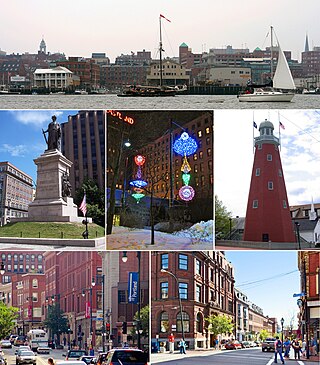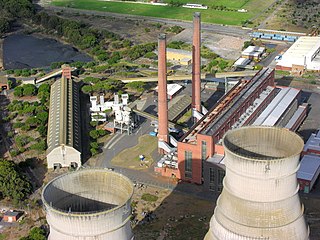
Electricity generation is the process of generating electric power from sources of primary energy. For utilities in the electric power industry, it is the stage prior to its delivery to end users or its storage.

Portland is a city in the U.S. state of Maine. It is the most populous city in the state and the seat of Cumberland County. Portland's population was 68,408 in April 2020. The Greater Portland metropolitan area has a population of approximately 550,000 people. Historically tied to commercial shipping, the marine economy, and light industry, Portland's economy in the 21st century relies mostly on the service sector. The Port of Portland is the second-largest tonnage seaport in the New England area as of 2019.

A power station, also referred to as a power plant and sometimes generating station or generating plant, is an industrial facility for the generation of electric power. Power stations are generally connected to an electrical grid.

Yankee Rowe Nuclear Power Station was a nuclear power plant in Rowe, Massachusetts, located on the Deerfield River in the town of Rowe in western Massachusetts. Its 180 MWe pressurized water reactor operated from 1961 to 1991. It produced electricity for New England consumers. The site is referred to as "Yankee-Rowe" or simply "Rowe", to avoid confusion with Vermont Yankee, another nuclear power station located in nearby Vernon, Vermont. The decommissioning of the site was completed in 2007.

Eraring Power Station is a coal-fired power station consisting of four 720 MW Toshiba steam-driven turbo-alternators for a combined capacity of 2,880 MW. The station is located near the township of Dora Creek, on the western shore of Lake Macquarie, New South Wales, Australia and is owned and operated by Origin Energy. It is Australia's largest power station. The plant has two smokestacks rising 200 m (656 ft) in height. It is slated for closure by mid-2025, after a failed attempt to sell the loss making power station back to the state government.

The Walter C. Beckjord Generating Station was a 1.43-gigawatt, dual-fuel power generating facility located near New Richmond, Ohio, 22 miles east of Cincinnati, Ohio. The plant began operation in 1952 and was decommissioned in 2014. It was jointly owned by Duke Energy, American Electric Power (AEP), and Dayton Power & Light (DP&L).

Great Yarmouth Power Station is combined cycle gas turbine power station on South Denes Road in Great Yarmouth in Norfolk, England, with a maximum output of 420 MW electricity, opened in 2001. It is built on the site of an oil-fired power station, built in 1958 and closed and demolished in the 1990s. A coal-fired power station was built in Great Yarmouth in 1894 and operated until 1961. The station is operated by RWE.

Coryton Power Station is a 732 MW Combined Cycle Gas Turbine (CCGT) gas-fired power station at Coryton, Thurrock, Essex, UK.

Roosecote Power Station was a gas-fired, originally coal-fired power station, situated in the Roosecote district of Barrow-in-Furness in Cumbria, North West England. The gas-fired station opened in 1991 and was the first CCGT power station to supply electricity to the United Kingdom's National Grid, but was mothballed in 2012 after a proposed biomass power station was cancelled. It was situated directly adjacent to Rampside Gas Terminal. The plant was demolished between 2014 and 2015. The site is now a 49 MW battery storage facility.

Cousins Island is an island in Casco Bay within the town of Yarmouth in Cumberland County, Maine, United States. It is listed as a census-designated place, with a population of 490 as of the 2010 census. The CDP is part of the Portland–South Portland–Biddeford, Maine Metropolitan Statistical Area.

The Tilbury power stations were two thermal power stations on the north bank of the River Thames at Tilbury in Essex. The 360 MW dual coal- and oil-fired Tilbury A Power Station operated from 1956 until 1981 when it was mothballed, prior to demolition in 1999. The 1,428 MW Tilbury B Power Station operated between 1968 and 2013 and was fueled by coal, as well as co-firing with oil and, from 2011, biomass. Tilbury B was demolished in 2016–19. Since 2013 three other power stations have been proposed or constructed in Tilbury.

Kashima Power Station is a large oil-fired and gas-fired power station in Kamisu, Ibaraki, Japan. The facility operates with an installed capacity of 5,660 MW, making it one of the largest fossil-fueled power station in the world. The plant includes four oil-fired steam turbines rated at 600 MW, two oil-fired steam turbines rated at 1,000 MW, and three advanced combined cycle gas turbines rated at 420 MW added in 2014. As of April 2016, the four oil-fired 600 MW turbines have been suspended indefinitely. The plant features 3 lattice stacks, including the tallest steel chimney in the world at 231m. In March 2023, JERA announced plans to decommission all six oil-fired steam turbines.

Fort Williams is a former United States Army fort in Cape Elizabeth, Maine which operated from 1872 to 1964. It was part of the Coast Defenses of Portland, later renamed the Harbor Defenses of Portland, a command which protected Portland's port and naval anchorage 1904–1950. After its closure, it was redeveloped into Fort Williams Park.

Yarmouth is a town in Cumberland County, Maine, United States, twelve miles north of the state's largest city, Portland. When originally settled in 1636, as North Yarmouth, it was part of the Massachusetts Bay Colony, and remained part of its subsequent incarnations for 213 years. In 1849, twenty-nine years after Maine's admittance to the Union as the twenty-third state, it was incorporated as the Town of Yarmouth.

Wyman Dam is a hydroelectric dam in Somerset County, Maine.
The West Side Trail is a multi-use trail in Yarmouth, Maine. A Town of Yarmouth project conceived in 1988 and opened in 2014, the trailhead for the eastern portion of the trail is in the parking lot of Tyler Technologies, on Tyler Drive, on the eastern side of U.S. Route 1, immediately before the exit 15 northbound on-ramp to Interstate 295 (I-295). The trailhead for the western section is in the park and ride lot at the southbound exit 15 ramp for I-295, to the west of Route 1.
Walter Scott Wyman was an American businessman. He was one of the two founders of Central Maine Power (CMP), whose Wyman Power Station is now named for his son, William Frizzell Wyman, the former president of CMP.
















